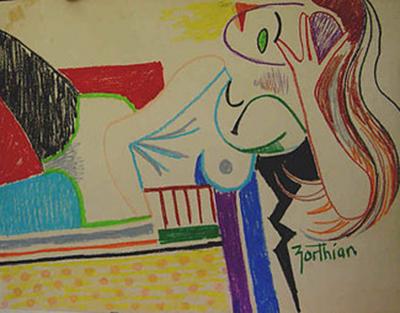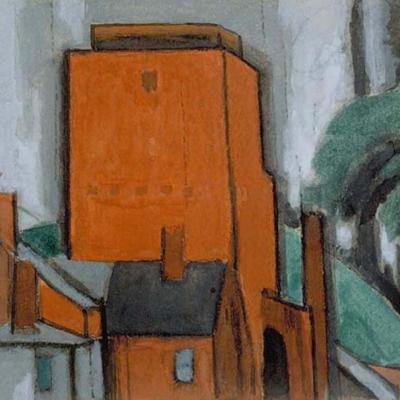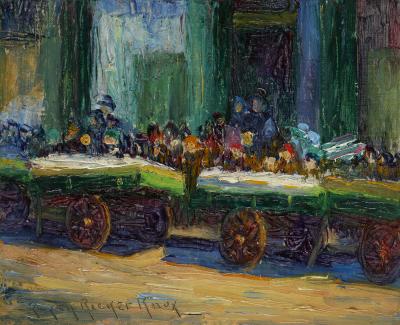The Armory Show at 100 Research Back Story
One Exciting Find
One aspect of my research for the New-York Historical Society’s exhibit(see The Armory Show at 100: Modern Art and Revolution) was to identify and locate as many as possible of the over 1400 objects included in the 1913 exhibition. For major works by major artists, this was a straightforward task. But for minor works by major artists and for works by more obscure artists, it was not so simple.
The Armory Show’s organizers printed a catalogue with artist names, titles of works, and media. In the 1960s, art historian Milton Brown compiled information on dates, sale prices, lenders, and purchasers, but, unfortunately, some of the titles in the 1913 catalogue are vague, and in many cases titles have changed.1 There were also few photographs of the exhibition’s New York venue. More images exist of the galleries in the Chicago venue, but only portions of the exhibit were on view there. And out of the over 1400 works in the New York exhibit, only fifty-seven were reproduced as Armory Show postcards. These challenges made my work stimulating, and in some cases, truly rewarding.
An oil painting, Morning on Long Island, by the American artist Oscar Bluemner (1867–1938) provided such a challenge (Fig. 1). Finding no trace of a painting by that title in any subsequent exhibitions or publications, or in the artist’s journals and diaries, I contacted Bluemner experts Barbara Haskell, Jeffrey R. Hayes, and Vera Bluemner Kouba. Each was helpful, but the consensus was that it would probably not be possible to locate the painting.
Combing the pages of Bluemner’s diaries for clues, I found this note: “The Hackensack river yellow houses, the Woodside Morning Hill (20 x 30) oils, hung in the International Exhibition, 69th Armory.”2 Bluemner had exhibited just two oils in the show—Hackensack River and Morning on Long Island—so it was clear that Morning on Long Island had an alternate title, Woodside Morning Hill. According to Bluemner’s diaries, Woodside Morning Hill was the only twenty by thirty inch oil painting of a Long Island morning scene that he made in 1911–1912.3
A list of his 1911–1912 paintings that appears on another diary page does not include Woodside Morning Hill or Morning on Long Island, but does mention a twenty by thirty inch oil on canvas titled Winfield L. I. Hill.4 Many of Bluemner’s titles refer to places: Woodside is a town in Queens, New York, situated at the western end of Long Island. A section of the town of Woodside is called Winfield. According to Bluemner’s diaries for the years 1916 to 1918, sometime in 1916–1917 he reworked the canvas known as Winfield L. I. Hill and retitled it Aspiration.5 Having left his paid work as an architect to focus on painting, Bluemner was living in poverty at the time and was unable to afford new canvases. Over the course of several months in 1916–1917 he transformed most of his 1911–1912 canvases to reflect his growing interest in the tenets of abstract painting that he had seen at the Armory Show. Sketches in Bluemner’s diary illustrate how the painting appeared prior to alteration (Fig. 2), and how he transformed the more traditionally rendered 1911–1912 landscape into the modernist composition that is now titled Aspiration, Winfield (Fig. 3).
The whereabouts of the painting after the Armory Show is unclear, but in 2005 the work was exhibited in a major Bluemner exhibition that Barbara Haskell organized at the Whitney Museum of American Art in New York, and while the accompanying catalogue indicates that the painting is one of the 1911–1912 canvases that Bluemner reworked in 1916–1917, it does not identify the earlier painting as the one that was in the Armory Show. I am pleased that my research for our exhibition has uncovered this important aspect of the painting’s history.
2. Painting and Theory Diaries: Painting Diary, 1912–1915, Box 1, Folder 32, p. 59, Oscar Bluemner papers, 1886–1939, 1960. Archives of American Art, Smithsonian Institution, available online at aaa.si.edu.
3. See Painting and Theory Diaries: Painting Diary, June 12, 1911–January 30, 1912; and Painting Diary, 1912–1915, Oscar Bluemner papers.
4. Painting and Theory Diaries: Painting Diary, June 12, 1911–January 30, 1912, Box 1, Folder 31, p. 207, Oscar Bluemner papers.
5. Painting and Theory Diaries: Painting Diary, 1916–1918, Box 1, Folder 35, pp. 37–41, Oscar Bluemner papers.


































